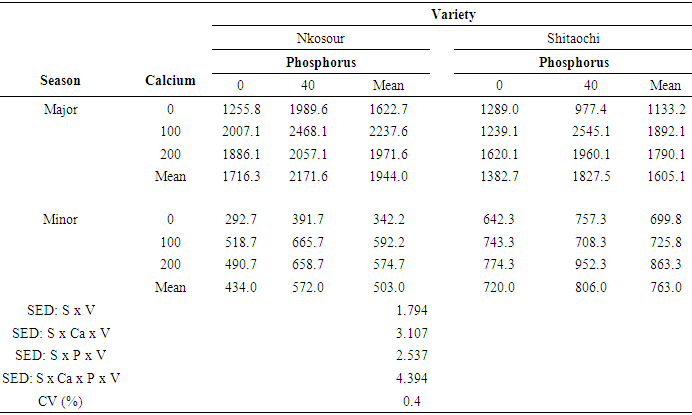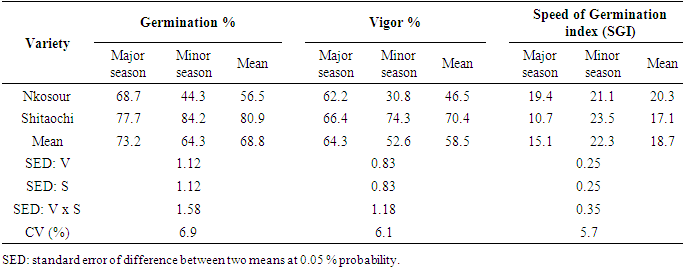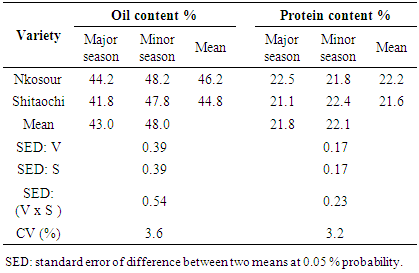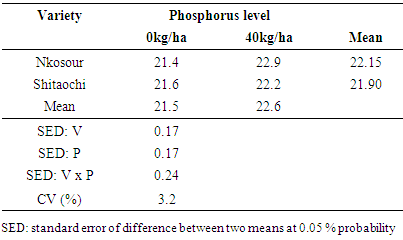-
Paper Information
- Next Paper
- Paper Submission
-
Journal Information
- About This Journal
- Editorial Board
- Current Issue
- Archive
- Author Guidelines
- Contact Us
International Journal of Agriculture and Forestry
p-ISSN: 2165-882X e-ISSN: 2165-8846
2017; 7(6): 129-133
doi:10.5923/j.ijaf.20170706.02

Effect of Calcium and Phosphorus Fertilizer on Seed Yield and Nutritional Quality of Groundnut (Arachis hypogaea L.)
Ernest G. Kamara1, Nana S. Olympio2, James Y. Asibuo J. Y.3, Milton K. Kabbia1, Keiwoma M. Yila1, Abdul Rahman Conteh1
1Sierra Leone Agricultural Research Institute, Njala Agricultural Research Centre, Freetown, Sierra Leone
2Department of Horticulture, Kwame Nkrumah University of Science and Technology, Kumasi, Ghana
3CSIR-Crops Research Institute, Kumasi, Ghana
Correspondence to: Ernest G. Kamara, Sierra Leone Agricultural Research Institute, Njala Agricultural Research Centre, Freetown, Sierra Leone.
| Email: |  |
Copyright © 2017 Scientific & Academic Publishing. All Rights Reserved.
This work is licensed under the Creative Commons Attribution International License (CC BY).
http://creativecommons.org/licenses/by/4.0/

The effect of calcium and phosphorus fertilizer on seed quality, oil and protein content of two groundnut varieties was investigated in two laboratory experiments. Seeds obtained from field experiments with plots treated with calcium and phosphorus fertilizers were tested. Germination and vigor percentages were determined using the sand method. First count was used to determine vigor and second count for germination percentage. Oil content was determined by the standard soxhlet extraction procedure using petroleum ether by Soxhlet apparatus. Crude Protein content was determined using the Kjeldahl method. The results showed that increased calcium fertilization increased the vigour, germination and oil content of the seeds of the two groundnut genotypes. Application of phosphorus fertilizer improved the protein content of the seeds. It was also observed that the protein and oil quantity varied with season and growing conditions. Higher protein and oil content were obtained from seeds of the minor season planting than the major season planting. The local variety, Shitaochi had higher vigour and germination percentages in both seasons whilst the improved variety had higher oil and protein content in both seasons. High seed yield was obtained in the major season while highest seed quality, oil and protein content were obtained in the minor season. In conclusion, it is preferable to grow groundnut in the minor season for high seed and nutritional quality and major season for high seed yield.
Keywords: Groundnut (Arachis hypogaea L.), Seed yield, Calcium, Seed quality, Protein, Oil content
Cite this paper: Ernest G. Kamara, Nana S. Olympio, James Y. Asibuo J. Y., Milton K. Kabbia, Keiwoma M. Yila, Abdul Rahman Conteh, Effect of Calcium and Phosphorus Fertilizer on Seed Yield and Nutritional Quality of Groundnut (Arachis hypogaea L.), International Journal of Agriculture and Forestry, Vol. 7 No. 6, 2017, pp. 129-133. doi: 10.5923/j.ijaf.20170706.02.
Article Outline
1. Introduction
- Groundnut (Arachis hypogaea L.) is an important food legume in Ghana in terms of consumption and area under production. Beside income for farmers, groundnut provides an expensive source of high quality dietary protein and oil. The seeds of most groundnut cultivars contain about 50% oil, 25-30% protein, 20% carbohydrate and 5% fibre and ash which make a substantial contribution to human nutrition (Fageria et al., 1997) [1]. The oil content of groundnut makes it an important crop for human consumption and livestock feed but vary in the relative proportion of fatty acids in different geographic locations, seasons and growing conditions (Brown et al., 1975) [2].For efficient groundnut production, farmers must have high quality seed. A uniform stand of healthy, vigorous seedlings is essential if growers are to achieve the yield and quality needed for profitable groundnut production. Thus seed quality is critical to growers. To produce high quality seed the crop must be properly handled. Seed quality of groundnut is influenced by seed Ca concentration, which is known to be affected by seed size and soil Ca fertility during seed production. An important aspect of calcium nutrition in groundnut is that the calcium taken up by the plant from soil will remain in the leaf tissues, and will not move from the leaves to the developing pods where its requirement is high. For this reason calcium should be sufficiently available in the podding zone at peg formation stage to pod maturity. Developing pegs and pods can directly absorb soil calcium similar to absorption by roots.Calcium deficiency results in lower yield and reduces the percentage of sound mature kernels. In addition, calcium deficiency has also been shown to decrease seed quality by inhibiting plumule development (Sullivan et al, 1974) [3]. Imbalance plant nutrition is one of the constraints for attaining maximum crop yield in rainfed condition. Phosphorus deficiency is one of the major factors underlying low crop productivity. Phosphorus application in the form of Single Superphosphate has been shown to increase both oil and protein content of groundnut seed (Elshiekh and Mohamedzein, 1998) [4]. Rahman (2006) [5] reported that oil and protein content of groundnut increased when calcium level was increased from 0 – 100kg/ha.Farmers in Ghana cultivate groundnut without using fertilizers resulting in poor quality seeds with low nutritional value. Under Ghanaian conditions, information on seed and nutritional quality of groundnut in relation to season, calcium and phosphorus fertilization is insufficient. Therefore, the objective of this study was to determine the effect of calcium and phosphorus on seed and nutritional quality of groundnut genotypes during the major and minor rainy seasons.
2. Materials and Methods
2.1. Description of Study Area
- Two field experiments were carried out at the Research fields of CSIR-Crop Research Institute at Fumesua (01°36'W; 06°43'N) during the major and minor rainy seasons in 2009. Fumesua is in the semi-deciduous forest zone with elevation of 186m above sea level (asl) and has a bimodal rainfall distribution. Total rainfall in the major and minor raining season was 993.3 and 215.3 mm, respectively during the study period. Air temperate varied from 21.1-31.4°C in the major rainy season to 22-32°C in the minor rainy season. Relative humidity was between 86 and 91% in the major rainy season and 77 and 89% in the minor rainy season.
2.2. Experimental Design and Cultural Practices
- A 2x2x3 factorial experiment laid in randomized complete block design was used in the study. Two levels of groundnut varieties (Nkosour an improved variety and Shitaochi, a local check), two levels of phosphorus (0 and 40kg /ha P2O5) in the form of Triple Superphosphate and three levels of calcium (0, 100 and 200 kg/ha Ca) in the form of oyster shell powder were evaluated The experimental areas were ploughed to a depth of about 20cm and harrowed. The seeds were planted at a spacing of 30 cm x 15 cm (row and hill) on plots 12 m2 (5m x 2.4m). Planting was done on the 5th May, 2009 in the major rainy season and 20th September, 2009 in the minor season. Phosphorus fertilizer was applied at sowing and oyster shell powder at 40days after planting during peak flowering and start of pegging. Harvesting was done on the two middle rows and the unshelled pods were sundried and put in paper bags and stored under ambient conditions in the open air in the farm house at CRI, Fumesua. The pods were shelled after three months. Seed yield was calculated and seeds were later tested for seed and nutritional quality.
2.3. Seed Quality Analysis
- Seed moisture content was measured by moisture meter (Wagtech International Moisture tester DMC 500). Seeds were germinated according to the ISTA Rules [6] (2007) for testing seeds. Sun-dried seeds from each treatment stored in paper bags at ambient temperature for three months were used for the germination test. 100 seeds were used for each of four replications. The seeds from each treatment were planted in sand containers (55cmx 42cm) in four replications, two replications per container. A completely randomized design was used in the study. Sterilised sand free from weed seeds was used as the medium for germination. For every 1 litre of sand, 160ml of water was added and mixed thoroughly with a hand trowel. The four replications were then placed under optimal germination condition for the period specified in the rules. The number of normal seedlings, abnormal seedlings and ungerminated seeds (dead and hard seeds) were recorded according on the 5th and 10th day to determine the vigor indicator and germination ability respectively.Speed of germination index (SGI) was calculated as described in the Association of Official Seed Analysts (AOAC, 2002) [7] handbook on vigour using the following formula:SGI = Number of normal seedlings (first count) /days to first count + Number of normal seedlings (final count) / days to final count.
2.4. Nutritional Analysis
- Oil content was determined by the standard soxhlet extraction procedure using petroleum ether by Soxhlet apparatus (AOAC, 1990) [7]. Crude Protein content was determined using the Kjeldahl method by measuring the total nitrogen content in the samples and then converting the figure to a total crude protein value by multiplication with conversion factor of 5.46 (Jones, 1931) [8]. Data was subjected to analysis of variance (ANOVA) using Genstat Release version 10.3 DE.4 and means separated using the standard error of differences at 5% probability level. Relationship among seed quality traits was explored using Pearson's correlation analysis.
3. Results and Discussions
3.1. Seed Yield
- Results of the study showed that calcium application significantly ( p = 0.001) affected seed yield of groundnut in both seasons. The treatment with 100 kg Ca ha-1 gave the highest seed yield (2232.6 and 1892.1 kg ha-1) of Nkosour and Shitaochi respectively whilst the control (Shitaochi) had the lowest seed (1133.2 kg ha-1) in the Major season. However, no significant difference was obseved between the 100 kg Ca ha-1 and 200 kg Ca ha-1 fertilizer applications in the two groundnut varieties in both seasons (Table 1). The lowest seed yield (503.0 kg ha-1) was obtained by Nkosour in the minor season. The application of the 100 kg Ca ha-1 increased seed yield by 38% in Nkosour and 67% in Shitaochi in the major season. The lowest mean seed yield lowest seed yield (342.2 kg ha-1 )was obtained by Nkosour variety without calcium and phosphorus in the minor season.The low seed yields obtained in the minor season could be attributed to the low rainfall (213 mm) which was below the minimum required amount (500 mm) for groundnut production. These results are in conformity with Boote et al (1982) [9] who reported that poor calcium upake during drought period resulted in severe calcium deficiency symptoms with reduced seed yield. Gasco and Davis (1994) [10] also established that calcium is critical for proper groundnut seed development.The results of the study also showed that generally the application of calcium fertilizer in combination of phosphorus consistently gave higher seed yields than the control without fertilizer (Table 1). The application of 40kg P2O5 kg ha-1 ha increased seed yield by 26% in Nkosour and 32% in Shitaochi during the major season, whilst in the minor season Nkosour had a 32% increase in mean seed yield and Shitaochi had 12% increase in seed yield. This could be attributed to the complementary role of phosphorus in increasing calcium absorption for groundnut pod filling. These results are consistent with earlier report by El-Habbasha (2005) [11].
|
3.2. Seed Quality Trait Analysis
- Seed vigor and germination percentages were higher in Shitaochi than Nkosour in both seasons. Germination percentage was higher in the major season in Nkosour variety (Table 2). Conversely, Shitaochi had a higher germination percentage (84.2%) and vigor percent (74.3%) in the minor season. This could be attributed to the dormancy exhibited by Nkosour, a hypogaea whilst Shitaochi, a fastigiata variety lacks dormancy. The application of calcium increased the germination percentage in groundnut. The application of 100Ca ha-1 fertilizer had the highest germination percentage in the major season planting, whilst in the minor season; application of 200 Ca ha-1 gave the highest germination percentage (Table 3). The lower germination recorded could be due low rainfall and high temperatures resulting in moisture stress.
|
|
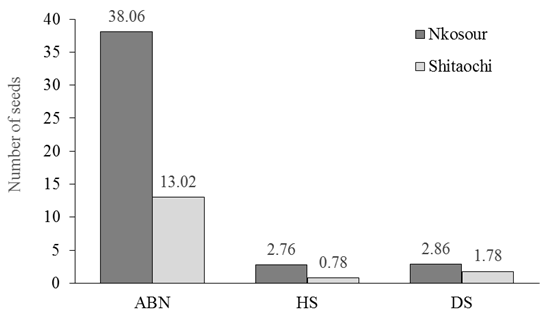 | Figure 1. Mean number of abnormal, hard and dead seeds of Nkosour and Shitaochi groundnut genotypes in the major and minor seasons |
3.3. Nutritional Quality
- Results of the current study showed that oil content range from 41.8% - 48.2%, similar to observations made by Okello (2010) [12] who indicated that groundnut seeds contain 40 – 50% fat. It was observed that highest oil content was obtained in the minor season in both groundnut varieties. The higher oil content observed in Nkosour, a Virginia market type is in conformity with the results of Dwivedi et al. (1993) [13] who observed that the Virginia cultivars had higher oil content than Valencia and Spanish lines. The results are also consistent with those of Brown et al., 1975 [2] who reported that oil content of groundnut differs in quantity, relative proportion of fatty acids, geographic location, season and growing conditions.Generally the protein content of treatments with phosphorus application had higher protein percentages than those without phosphorus application (Table 4). The application of phosphorus fertilizer increased protein content by 7% and 3% in Nkosour and Shitaochi respectively. These results are consistent with earlier results obtained by (Elshiekh and Mohamedzein, 1998) [4].
|
3.4. Correlation of Seed Quality Traits
- Results obtained from correlation analysis showed a significant strong positive correlation (r = 0.91, P < 0.0001) between vigor and germination percentage. Similarly, a positive correlation was observed speed of germination index and germination (r = 0.94, p < 0.0001) while number of abnormal seeds, hard seeds, dead seeds and germination percent were negatively correlated (Table 5). There was very weak correlation (r = 0.24) between protein and oil content in the two groundnut varieties studied.
|
|
4. Conclusions
- Vigor and germination capacity of the seed increased with increase calcium application. Seeds produced in calcium deficient conditions will exhibit much poorer germination than those produced with adequate calcium supply. The results of the study also indicate that calcium application improved the oil content whilst phosphorus application increased the protein content of the seeds. Oil and protein content of the seed varied with season and growing conditions. Higher oil and protein content were obtained in the minor season than the major season. Thus efforts to improve conditions for better yield in the minor season will result to high seed quality and nutritional value.
ACKNOWLEDGEMENTS
- This research was funded by AGRA (Alliance for a Green Revolution in Africa). The efforts of Favour and Dr. Asuboah of Grains and Legumes Development Board and Acquah of Soil Science, Kwame Nkrumah University of Science and Technology in conducting these experiments are highly appreciated and acknowledged.
 Abstract
Abstract Reference
Reference Full-Text PDF
Full-Text PDF Full-text HTML
Full-text HTML